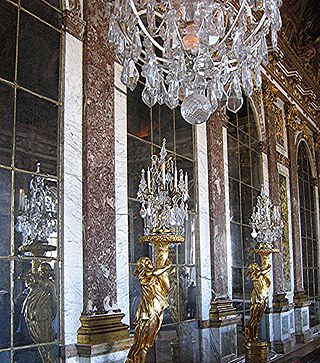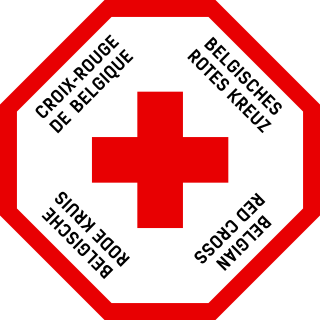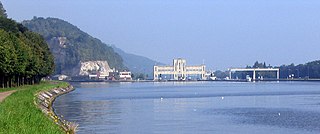
Belgium is a constitutional, hereditary and popular monarchy. The monarch is titled King of the Belgians and serves as the country's head of state and commander-in-chief of the Belgian Armed Forces. There have been seven Belgian monarchs since independence in 1830.

The national flag of Belgium is a tricolour consisting of three equal vertical bands displaying the national colours of Belgium: black, yellow, and red. The colours were taken from the coat of arms of the Duchy of Brabant, and the vertical design may be based on the flag of France. When flown, the black band is nearest the pole. It has the unusual proportions of 13∶15.

The Communist Party of Belgium is a communist party in Belgium. It was founded in Wallonia in 1989 as the Communist Party of Wallonia after the Communist Party of Belgium was bifurcated along linguistic lines, and refounded as the PCB following the extinction of its counterpart in Flanders. Pierre Beauvois was the General Secretary of the party to 2006.

The Royal Museums of Fine Arts of Belgium are a group of art museums in Brussels, Belgium. They include six museums: the Oldmasters Museum, the Magritte Museum, the Fin-de-Siècle Museum, the Modern Museum, the Antoine Wiertz Museum and the Constantin Meunier Museum.

Griotte is a cultural and old trade name given to a type of marbles and limestones. The natural stone is deep cherry-red to brown in colour, often flecked with small dashes of purple and/or spots and streaks of white formed by Goniatites or by later cementation. It is sometimes known as Cannes marble.

Rouge de Rance is a Devonian red reef limestone from the town of Rance in the province of Hainaut.

Noir Belge is collective noun referring to black limestone found on several sites in Belgium. Some trade names refer more specifically to the quarry where the material was found, for example "Noir de Mazy" or "Noir de Golzinne". Some Noir belge marble deposit belongs to a fine-grained calcareous sedimentary formation dated Frasnian era and located on the northern border of Namur sedimentary basin. A few black limestones located in the lower Carboniferous
Belgian marble is the name given to limestone extracted in Wallonia, southern Belgium.

The Belgian Red Cross is a humanitarian organization that aids in providing emergency and disaster related services and relief as well as providing education for disaster awareness within the population of Belgium. It is a member of the International Federation of Red Cross and Red Crescent Societies.
The Union des progressistes juifs de Belgique is a Belgian Jewish organization set up in 1939 as Solidarité juive by antifascist Jews in Belgium, becoming in 1946 Solidarité juive, aide aux victimes de l'oppresseur nazi. It took on its present name in 1969.

Mount Saint Peter, also referred to as Caestert Plateau, is the northern part of a plateau running north to south between the valleys of the river Geer to the west, and the Meuse to the east. The plateau runs from Maastricht in the Netherlands, through Riemst in Belgian Limburg almost to the city of Liège in Belgium, thus defining the topography of this border area between Flanders, Wallonia and the Netherlands. The name of the hill, as well as the nearby village and church of Sint Pieter and the fortress of Sint Pieter, refers to Saint Peter, one of the Twelve Apostles.

Rouge Cloître (French) or Rood-Klooster (Dutch) is a former Augustinian Priory, founded in 1367. It is located in the Sonian Forest, in south-eastern Brussels, Belgium. It was abolished in 1796. Today, it is administered from Auderghem, which is a commune of Brussels.
The Croix de guerre (French) or Oorlogskruis (Dutch) is a military decoration of the Kingdom of Belgium established by royal decree on 25 October 1915. It was primarily awarded for bravery or other military virtue on the battlefield. The award was reestablished on 20 July 1940 by the Belgian government in exile for recognition of bravery and military virtue during World War II. The post-1940 decoration could also be awarded to units that were cited. The decoration was again reestablished by royal decree on 3 April 1954 for award during future conflicts.
The Évence Coppée Trophy was a one-off competition comprising a single association football match in 1904 between Belgium and France. Held at the Stade du Vivier d'Oie in Uccle, Belgium, the match ended in a 3–3 draw.
The Royal Academy of Science, Letters and Fine Arts of Belgium is the independent learned society of science and arts of the French Community of Belgium. One of Belgium's numerous academies, it is the French-speaking counterpart of the Royal Flemish Academy of Belgium for Science and the Arts. In 2001 both academies founded a joint association for the purpose of promoting science and arts on an international level: The Royal Academies for Science and the Arts of Belgium (RASAB). All three institutions are located in the same building, the Academy Palace in Brussels.
The Académie royale de langue et de littérature françaises de Belgique - Royal Academy of French Language and Literature of Belgium - or ARLLFB is a Belgian institution which brings together personalities who, through their works, writings, lectures or speeches, have contributed most eminently to the illustration of the French language, either by studying its origins and its evolution, or by publishing works of imagination or criticism. It includes both Belgian and foreign members.
Events in the year 1842 in Belgium.
Anarchism spread into Belgium as Communards took refuge in Brussels with the fall of the Paris Commune. Most Belgian members in the First International joined the anarchist Jura Federation after the socialist schism. Belgian anarchists also organized the 1886 Walloon uprising, the Libertarian Communist Group, and several Bruxellois newspapers at the turn of the century. Apart from new publications, the movement dissipated through the internecine antimilitarism in the interwar period. Several groups emerged mid-century for social justice and anti-fascism.

Eugénie Hamer was a Belgian journalist, writer and activist. Her father and brother served in the Belgian military, but she was a committed pacifist. Involved in literary and women's social reform activities, she became one of the founders of the Alliance Belge pour la Paix par l'Éducation in 1906. The organization was founded in the belief that education, political neutrality, and women's suffrage were necessary components to peace. She was a participant in the 18th Universal Peace Congress held in Stockholm in 1910, the First National Peace Congress of Belgium held in 1913, and the Hague Conference of the International Congress of Women held in the Netherlands in 1915. This led to the creation of the International Committee of Women for Permanent Peace, subsequently known as the Women's International League for Peace and Freedom (WILPF). Hamer co-founded the Belgian chapter of the WILPF that same year. During World War I, she volunteered as a nurse and raised funds to acquire medical supplies and create an ambulance service.